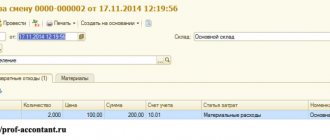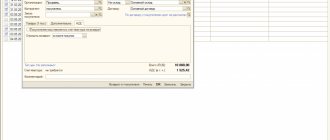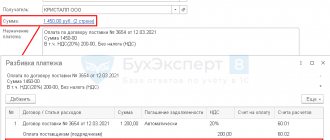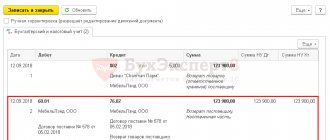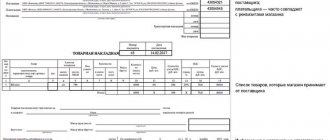Home / Complaints, courts, consumer rights / Consumer rights
Back
Published: 10/19/2018
Reading time: 8 min
1
734
When the quality of goods does not meet the technical conditions and standards accepted in this area, then we can say that this product contains a manufacturing defect.
- Legal regulation and grounds for returning defective goods
- What rights does the buyer have?
- Return deadlines
- How to make a return
These products cannot be used for their intended purpose without additional costs to correct defects or without additional processing. Each industry has its own criteria for classifying products as defective.
Return of defective goods from the buyer
In the buyer's accounting, the procedure for recording the return of low-quality goods depends on whether the defect was discovered immediately upon acceptance of the goods or after it was accepted for accounting.
When returning goods before they are accepted for accounting, the contract is terminated unilaterally, the goods are not accepted for registration by the buyer, and the ownership of it is retained by the seller. The buyer notifies the seller of the violation of the terms of the contract (Article 483 of the Civil Code of the Russian Federation) and accepts the goods for safekeeping. Defective goods are accepted for accounting in off-balance sheet account 002 “Inventory assets accepted for safekeeping” in the assessment according to shipping documents (by a simple debit entry to account 002). When the goods are returned to the supplier, the cost of the goods is written off from off-balance sheet accounting by a simple entry on the credit of account 002.
A separate transaction reflects the receipt of funds from the supplier for the submitted claim:
DEBIT 51 CREDIT 76 subaccount “Settlements for claims”
- funds received from the supplier for a claim.
Accounting for the return of goods before acceptance for accounting and receipt of funds requires the completion of only three business operations:
- an invoice for receipt of goods is registered;
- an invoice for writing off the goods is registered;
- The bank statement showing the receipt of funds is reflected.
If a defect is discovered after acceptance of the goods, the buyer makes a claim to the supplier for the value of the defective goods. Settlements on claims are recorded in account 76.6 “Settlements with various debtors and creditors”, subaccount “Settlements on claims”.
Typically, examples are used to consider operations for returning goods with payment after receipt of the goods.
We will look at an example of returning a product, complicating it by paying an advance to the supplier. Example 1
Riviera LLC bought a batch of nails from StroyBarier LLC (120 boxes of 3 kg each) for 25,000 rubles.
Before accepting the goods, Riviera transferred fifty percent of the cost for the goods in advance. After the goods arrived at the warehouse and were registered, it was discovered that almost all the nails were missing heads - the goods were rejected. The nails were returned to the supplier, and a claim was sent to him for the return of the previously paid advance. The accountant makes the following accounting entries: DEBIT 60 subaccount “Advances” CREDIT 51
- 12,500 rubles.
— paid to the supplier for goods (advance); DEBIT 68 CREDIT 76
- 1906.78 rub.
— VAT deduction on advance payment issued to the supplier is reflected; DEBIT 41 CREDIT 60
- 25,000 rub.
— goods received from the supplier are accepted for accounting; DEBIT 19 CREDIT 60
- 3813.56 rubles.
— input VAT is taken into account; DEBIT 60 CREDIT 60 subaccount “Advances”
- 12,500 rubles.
— the advance payment has been credited against the previously received prepayment; DEBIT 68 CREDIT 19
- 3813.56 rub.
— the supplier’s invoice is registered; DEBIT 76 CREDIT 68
- 1906.78 rub.
— VAT on advances issued has been restored; DEBIT 76 CREDIT 41
- 25,000 rub.
— goods are returned to the supplier; DEBIT 76 CREDIT 68
- 3813.56 rubles.
– VAT accrued is taken into account; DEBIT 51 CREDIT 76
- 12,500 rub. — funds were returned according to the reconciliation report.
Buyer registration rules.
When returning goods to the supplier, what documents need to be drawn up first? First of all, the return is recorded in the reporting.
If the registration is based on the fact that the delivered goods do not comply with the terms of the contract, when the merchandiser finds this out at the time of acceptance of the goods, fill out the unified TORG form No. 2.
This means failure to fulfill the terms of the purchase and sale agreement; everything that was brought is temporarily accepted for safekeeping.
When a return is issued after the goods have been received, an arbitrary act, an invoice, is drawn up. There is no special (unified) form provided.
Important to consider! It is better if the act is drawn up in the presence of a representative of the selling company, so that there are no complaints in the future.
Then the documents and the letter of claim are sent to the supplier organization, an act and a requirement to accept the goods to be returned are attached. A return invoice is issued.
Return of defects from the supplier
Particular attention should be paid to accounting for the return of goods from the supplier, taking into account advance payments, because The situation under consideration is complicated by the accrual of VAT on the advance and the reflection of the deduction of VAT on advances received, which involves the implementation of the following business transactions.
Let's consider this as a continuation of example 1.
Example 2
The accountant of StroyBarier LLC makes the following entries:
DEBIT 51 CREDIT 62 subaccount “Advances”
- 12,500 rubles.
— received funds to the bank account from the buyer (advance); DEBIT 76 CREDIT 68
- 1906.78 rub.
— an invoice for the advance payment has been issued; DEBIT 62 CREDIT 90.1
- 25,000 rub.
— revenue from the sale of goods is reflected; DEBIT 90.3 CREDIT 68
- 3813.56 rub.
— VAT is charged on the shipment of goods; DEBIT 90.2 CREDIT 41
- 20,000 rub.
— reflects the cost of goods sold; DEBIT 62 subaccount “Advances” CREDIT 62
- 12,500 rub.
— the advance payment previously received from the buyer is offset; DEBIT 68 CREDIT 76
- 1906.78 rub.
— VAT deduction on advances received is reflected; DEBIT 62 CREDIT 90.1
- 25,000 rub.
— adjustment of sales (reversal); DEBIT 90.2 CREDIT 41
- 20,000 rub.
– adjustment of write-off of goods sold (reversal); DEBIT 90.3 CREDIT 19
- 3813.56 rub.
— adjustment of accrued VAT (reversal); DEBIT 62 subaccount “Advances” CREDIT 62
- 12,500 rub.
— adjustment of the offset advance (reversal); DEBIT 68 CREDIT 19
- 1906.78 rub.
— VAT has been accepted for deduction (registration of an invoice for refund); DEBIT 62 subaccount “Advances” CREDIT 51
- 12,500 rub. — money was returned to the buyer.
How to determine the presence of a marriage
There is a certain classification of defects that should be followed when inspecting the product and identifying defects. Based on this classification, the amount of compensation is determined:
- For products, a defect is considered to be a change in taste characteristics.
- Complex devices and instruments may not meet technical specifications.
- A defect is considered a violation of quality requirements during production.
- Violation of the appearance of the goods.
The presence of defects and defects may not be the fault of the manufacturer alone, although this option is the most common. The product sometimes suffers during transportation, when not only its packaging, but also the body and design are damaged. The seller may also be at fault if he does not store the goods correctly or treats them carelessly.
In this case, the refund should be at the expense of the retail establishment, and not the manufacturer or supplier. But in all these cases, the buyer has the right to demand an exchange or refund. The exception is damage to the product by the buyer himself, and this will not be difficult to establish with a special examination.
If the sale and return of defective goods are made in different tax periods
When a defective product is returned by the buyer, the procedure for recording transactions in the seller’s accounting differs depending on the period in which the defective product was returned (during the sales period or the next year after sale).
In accordance with paragraph 6 of PBU 9/99 “Income of the organization”, revenue is accepted for accounting in an amount calculated in monetary terms equal to the amount of receipts of cash and other property and (or) the amount of accounts receivable.
If the buyer returns a product of poor quality, the purchase and sale agreement is considered terminated in part of this product; it is considered that the ownership of the defective product has not passed to the buyer.
Based on clause 80 of the Regulations on accounting and financial reporting in the Russian Federation, approved by order of the Ministry of Finance of Russia dated July 29, 1998 No. 34n, a decrease in revenue as a result of the return of low-quality goods identified in the next year is reflected as a loss identified in the reporting period. year (clause 12 of PBU 10/99 “Expenses of organizations”). In this case, corrections and (or) clarifications are not made to the financial statements of the previous year.
Let's consider the operation of returning goods sold in the previous reporting period from the supplier's perspective.
Let’s use the previous data and just imagine that the shipment and return of the defective items occur in different tax periods. Example 3
The accountant of StroyBariera must make the following entries:
DEBIT 91.2 CREDIT 62
- 25,000 rubles.
— the return of goods sold in the previous calendar year is reflected as other expenses of the reporting period; DEBIT 41 CREDIT 91.1
- 20,000 rub.
— the previously written-off cost of goods returned by the buyer was restored; DEBIT 68 CREDIT 91.1
- 3813.56 rubles.
— VAT has been accepted for deduction (registration of an invoice for return).
How to prove inadequate quality of a product?
In cases where a defect is discovered during operation, the buyer will need to prove the fault of the manufacturer or seller. The evidence may include video or photography, witness testimony or the results of an independent examination. An expert's opinion is the most reliable evidence.
Payment for examination services is made by the seller after claims are presented to him, but if the expert determines that the buyer is to blame for the defect, he will be required to compensate for the costs.
Returning goods from an individual
The procedure for returning goods purchased under a retail purchase and sale agreement is regulated by Chapter 30 of the Civil Code and the Law of the Russian Federation of February 7, 1992 No. 2300-1 “On the Protection of Consumer Rights.”
The list of goods that cannot be returned was approved by Decree of the Government of the Russian Federation of January 19, 1998 No. 55. Such goods include perfumes, textiles, jewelry, cars, etc.
In cases of lawful return of goods, the seller is obliged to accept the sold goods back and return the money to the buyer.
Example 4
Tekstil LLC sold a dress to citizen O.G. Ivanova.
at a price of 2500 rubles. The next day Ivanova returned the dress - a defect was discovered. The defective goods were returned to the store, and citizen Ivanova was reimbursed. The accountant makes the following entries in the accounting: DEBIT 76 CREDIT 90.1
- 2,500 rubles.
— revenue from the sale of goods returned by the buyer (reversal); DEBIT 90.2 CREDIT 41
- 2000 rub.
— the purchase price of the goods returned by the buyer (reversal); DEBIT 90.3 CREDIT 68
- 381.36 rub.
– VAT on the returned goods is taken into account (reversal); DEBIT 76 CREDIT 50
- 2500 rub.
— the buyer’s money was returned; DEBIT 41 CREDIT 76
- 2,000 rub.
— the goods are capitalized at the sales price; DEBIT 90.2 CREDIT 42,500
rub.
— The trade markup has been restored.
What to do in case of refusal
When a breakdown is the responsibility of the manufacturer and seller selling a product that is known to be of low quality, the buyer has every right to an exchange or refund. This right is given by the Law on the Protection of Producers' Rights. You should take the receipt and purchase to the retail establishment where the item was paid for and fill out a statement.
You can send a letter of claim to the seller by mail or registered mail, if he does not want to take the application in hand and fill it out.
The establishment must respond to the complaint within 10 days. The product is exchanged, repaired or refunded. The store may determine that the breakdown was caused by the buyer, in which case the return will be refused.
When a trading establishment has accepted a claim and promises to return the funds, it is given a certain period of time to fulfill the promise, in accordance with Articles 20-22 of the previously mentioned law.
If the deadline is violated, the consumer can go to court, demanding not only the return of money, but also payment of compensation as a penalty. The penalty is usually 1% of the purchase price. Also, the court, having been convinced that the consumer is right, may also order the store to pay a fine in the amount of 50% of the price for violating consumer rights legislation.
ATTENTION! You can also obtain compensation for moral damages. But the buyer must also comply with all legal regulations and follow the procedure for returning defective goods.
You should first have a conversation with the store, with the seller. Typically, trading establishments rarely refuse to return defective goods, as this may affect their image; moreover, compliance with legal norms is also important. And only after an unfounded refusal is it necessary to write a statement of claim to the court.
How to document the return of goods?
Peculiarities of document flow and exchange of goods can be enshrined in a purchase and sale or supply agreement. For example, the contract may stipulate that the return of goods is carried out on the basis of a claim, which is sent by email, fax or other accessible method; the contract may establish specifics of the costs of returning the goods, the accrual of penalties, etc.
Returning goods from the buyer requires the preparation of the following documents:
- act on the discovery of defects in the goods;
- claim.
Documents are drawn up in free form. You can use some standard acts that were previously approved by the State Statistics Committee - the form of an act on the established discrepancy in quantity and quality when accepting inventory items No. TORG-2 (for imported goods - form No. TORG-3).
If the act is drawn up in any form, then the mandatory details should be indicated in the act in accordance with Article 9 of Law 402-FZ “On Accounting”.
The act is signed by representatives of both parties (unilateral drawing up of the act is possible with the consent of the supplier or in its absence), it serves as the basis for filing claims and lawsuits. The claim to the product is signed by the buyer.
The seller must prepare the following documents:
- register the returned goods;
- issue an adjustment invoice to the buyer;
- transfer the invoice with corrections to the buyer.
If a product is returned, a correction invoice will be issued. In accordance with Article 169 of the Tax Code, it is issued when the cost of goods shipped (work performed, services provided) or transferred property rights changes. In particular, it is issued in the event of a change in price (tariff) and (or) clarification of the quantity (volume) of goods supplied (shipped) (work performed, services rendered), property rights.
The buyer must issue a delivery note to the seller for the shipment of goods received from him. This is stated in paragraph 2.1.9 of the Methodological Recommendations for accounting and registration of operations for the receipt, storage and release of goods in trade organizations, approved by the letter of Roskomtorg dated July 10, 1996 No. 1-794/32-5 (hereinafter referred to as the Methodological Recommendations of Roskomtorg). It is advisable to make a note “Return of goods” on the delivery note (form No. TORG-12).
Return of unsold goods to the supplier. Reverse implementation
You, as a buyer, have no complaints about the product, but you have agreed with the supplier to return the unsold goods to him at some point in time. Here, as in the previous case, the reverse implementation takes place. Typically, the supply agreement specifies the possibility of returning unsold goods to the supplier. For example, reverse sales can be carried out if the products were not sold by a certain date.
Essentially, by going through this process, you are selling the item to its former owner. This means you give him a TORG-12 consignment note and an invoice, where you indicate the name of your company in the “Seller” column. The TORG-2 act is not filled out, since you are returning a quality product to the supplier. Thus, in this case, from the point of view of documentation, the reverse implementation is no different from the direct one.
To process a return, you will need the forms listed in the article. You can download any forms of documents and samples of their completion, including TORG-12 and TORG-2, on our website.
Documentation of goods from the seller in retail trade
When returning goods on the same day, that is, before the Z-report is taken at the checkout, the seller must:
- collect the cash receipt from the client and sign it from the manager;
- draw up a money return act in the KM-3 form;
- issue an invoice for the returned goods;
- return the money.
The invoice can be drawn up in the TORG-13 form (invoice for internal movement, transfer of goods, containers). The check signed by the manager is presented to the operating cash desk, and the money is returned to the buyer.
The check received from the buyer is attached to the act (in the KM-3 form) and submitted to the accounting department. Amounts paid for returned customers and unused cash receipts are reflected in the cashier-operator's journal in column 15. The amount of revenue for a given day is reduced by these amounts.
If the goods are returned to the seller later than the day the goods were purchased, the following documents are drawn up:
- the buyer draws up an application and attaches a cash receipt or sales receipt to it;
- the seller issues an invoice for the returned goods in two copies (one is attached to the product report, and the second is given to the buyer and is the basis for receiving a sum of money for the returned goods);
- the seller gives the buyer money and draws up a cash order;
- the seller makes accounting corrections.
VAT and ONS
Returning goods should be taken into account when preparing reports to the tax service. Since transactions occur through cash registers, this factor should be taken into account and documentation must be maintained correctly to avoid problems during audits and accusations of tax evasion:
- ONS . In case of a refund, it is necessary to adjust the income in KUDiR by indicating in the “Income” column the amount of the return with a minus sign. The cost of goods is also corrected, but in the “Expenses” column. This is necessary in order not to violate the correctness of tax accounting. It is advisable to support the recording with an appropriate act.
- VAT . The buyer is not a VAT payer, therefore, when returning money, the amount is reflected in the seller’s purchase book. The entry must be supported by an act of return of the goods. The total tax base upon payment is reduced by the amount received from the sale of goods, and the company itself does not incur tax costs.
Errors in registration can lead to serious sanctions. Violations are considered as violations of the procedure for working with cash and are subject to Article 15.1 of the Administrative Code of the Russian Federation.
Officials pay a fine of 4,000 to 5,000 rubles, while an enterprise can pay a fine of 40,000 to 50,000 rubles.
VAT accounting for the seller
According to the Russian Ministry of Finance, when returning goods that were not accepted for registration by the buyer, the seller issues an adjustment invoice for a decrease in value due to a decrease in the number of goods shipped. He registers this invoice in the purchase book during the period when the right to deduction arises (clause 12 of the Rules for maintaining the purchase book, approved by Decree of the Government of the Russian Federation of December 26, 2011 No. 1137). Adjustment invoices are applied only if the buyer returns to the seller part of the goods not accepted by him for accounting. If the buyer refuses to accept the entire shipment, then the seller, in order to claim a tax deduction, registers in the purchase book his own invoice issued upon shipment of goods (see letter of the Federal Tax Service of Russia dated April 11, 2012 No. ED-4-3/6103) .
Returning low-quality goods to the supplier
Imagine that you are the owner of a small grocery store and they brought you expired kefir for sale. How to return a product with an expiring date to the supplier? In this case, you can simply not accept damaged positions. It is enough to correct the invoice - without documenting the return of low-quality goods to the supplier. That is, if he is ready to take back the expired products, then from the TORG-12 consignment note that he brought, you can cross out the necessary items - those that are defective. Please note that corrections in the receipt document must be made in the presence of the supplier or his representative - a forwarder or driver, vested with the rights of a financially responsible person. This person must sign next to the crossed out item and pick up the defective product.
If you pay VAT, then the supplier must not only accept the defect back, but also adjust the invoice down for you and send it to you within 5 working days. After all, you bought less goods.
New return policies apply for 2021. Now, if the buyer returns the goods to the supplier, then it is the supplier who issues the adjustment invoice for the return. On the invoice, in the adjustment lines, the supplier indicates the goods that it must accept from the buyer.
The same rule applies if the buyer plans to return an item purchased in 2021. But in this case, in the adjustment invoice you need to indicate the VAT rate not 20%, but 18%.
Until 2021, the buyer was responsible for invoicing when returning goods. And the seller accepted back his own goods according to documents from the buyer.
There is another option: additional delivery of quality goods at another time, but without paperwork. You accept the entire delivery by signing the delivery note without any adjustments. And the supplier promises to bring the missing quality goods a little later. This is a common case when you already have an established and trusting relationship with the supplier.
Accounting for VAT from the buyer
The buyer notifies the seller of the violation of the terms of the contract (Article 483 of the Civil Code of the Russian Federation) and accepts the goods for safekeeping. The return of goods not accepted for registration is not a sale, therefore the buyer does not prepare an invoice (clause 1 of Article 39, subclause 1 of clause 1 of Article 146, clause 3 of Article 168, clause 3 of Article 169 of the Tax Code of the Russian Federation) .
If the buyer refuses to accept the entire consignment of goods, then VAT on the invoice received from the seller is not claimed for deduction (clause 2 of Article 171, clause 1 of Article 172 of the Tax Code of the Russian Federation, letter of the Ministry of Finance of Russia dated March 7, 2007 No. 03 -07-15/29). The invoice received from the seller is not registered in the purchase book (clause 2 of the Rules for maintaining the purchase book, approved by Decree of the Government of the Russian Federation of December 26, 2011 No. 1137).
If the goods are returned partially, then the buyer claims VAT on the shipping invoice only for the part of the goods actually registered. The buyer receives an adjustment invoice from the seller for the change in price. Such an invoice is not registered by the buyer in the sales book, since there is no obligation to restore VAT under subparagraph 4 of paragraph 3 of Article 170 of the Tax Code.
T. Lesina,
accountant, for the magazine “Regulatory acts for accountants”
Help in solving practical situations
Since 2001, the Practical Accounting magazine has published articles with specific solutions and recommendations. The publication is now also available in electronic form. Get full access to all materials >>
If you have a question, ask it here >>
Under warranty
If the product has a warranty, the seller must indicate this fact to the buyer immediately, while still in the store. The consumer must know the warranty period and the conditions for its use. And if a defect is detected or if there is a breakdown beyond the control of the buyer, the goods can be returned in the following ways:
- The manufacturer carries out repairs at its own expense.
- The retail establishment reimburses the cost of repairs if they were carried out not in the service center, but in another workshop.
- An exchange is made for the same product, but with proper quality, or a similar one.
- A refund of the money spent on the purchase is possible.
- If the buyer agrees, he simply receives a discount on payment for this product with a defect or defect.
The warranty period may vary for different types and types of goods. It depends on the complexity, on the functions, on the manufacturer’s brand, and cost.
Returning defective goods to the supplier after accepting it for registration
If the buyer discovers a defect after accepting the goods, he must send a claim to the seller. The claim indicates the amount to be returned, which is equal to the cost of the defective product. All settlements for monetary claims are reflected in account 76.6.
Accounting reflects payment for goods, deduction of VAT, acceptance of goods for accounting, input VAT and registers the supplier's invoice. Next, the return of the goods to the supplier is recorded, including VAT, as well as the return of money according to the reconciliation report.
Procedure for returning an item purchased remotely
It is possible to return the product to the seller in any case, regardless of how it was purchased, remotely or in the store.
A prerequisite is preservation of presentation, no signs of use, preservation of factory tags, seals, and packaging.
When written information about the return process is not provided, the consumer has 3 months. When returning a product purchased remotely, the buyer pays for shipping.
If there is no address, the consumer receives all the necessary information on the tax website, when entering the company’s TIN.
The seller’s website must contain information on the return procedure and a form for communicating with the sales manager. Almost every online trading platform has a sample claim for returning goods of inadequate quality. You will need to download and print the completed form and attach it to the return parcel.
If there is no form, write the claim by hand:
- title “Return Application”;
- Order number;
- date of receiving;
- in the items to be returned, write the name, model, quantity, price;
- procedure for returning money (amount, convenient method);
- date of writing, signature.
You can return your order through:
- Pick-up point. A return form is filled out, a certificate of transfer of the product and the state of appearance is drawn up.
- Courier delivery. The goods are packaged together with the application and a photocopy of the payment receipt.
- Postal service. The parcel is packaged only by post, taking into account the contents and receipt of delivery. After sending, the consumer is left with an inventory and a postal receipt.
Financial resources are returned within a 10-day period from the moment the recipient receives the package.
How to make a return without paperwork
This option is possible if you have a trusted supplier and have established a trusting relationship with him. Here, a verbal agreement between you will be sufficient about when you can return the spoiled or damaged products and receive a quality product in return. Any supplier who values its reputation and its customers will be happy to meet you halfway in this matter and will try to exchange the defect as soon as possible. The issue of when to sign the delivery note is also decided jointly.
Law on Consumer Protection"
Throughout life, a person consumes various resources - food, water, clothing, electricity, the Internet. Legal entities are also consumers, so consumption is distinguished:
- formal;
- informal.
In 1992, the ZPPP came into force. In the USSR, quality control was carried out through the supervision of state structural units, mainly in the trade and production areas.
The population needed quality goods, which contributed to the adoption of the STD law.
Provisions of the Civil Code of the Russian Federation and Article 25:
- The rights and responsibilities of producers, sellers and consumers are established. The manufacturer bears full responsibility for the low-quality goods he produces.
- Reservation of rights when purchasing goods through a store or online. This part of the consumer rights law describes the return and exchange of goods of inadequate quality, and monetary compensation. The fundamental point is the deadline for filing a complaint.
- Reservation of rights in the provision of services through the conclusion of an estimate agreement. He is a guarantor of the quality of work performed and payment.
The consumer has the exclusive right to return or exchange purchased goods within 14 days, excluding the day of purchase.
Conditions for exchange/return of defective goods
It is possible to return/exchange goods without defects within two weeks.
The condition for exchange/return is an oral or written complaint. Before replacing, you should make sure that the malfunction was not caused by improper use. In a doubtful situation, the seller has the right to use the services of an independent expert examination.
The list of products that cannot be replaced includes defective products that are under warranty. The 2 week period does not apply to them. If there is no analogue, the seller is obliged to return the money.
There are 14 days for returns (exchanges); after this time, goods with minor flaws cannot be returned.
The following conditions must be met:
- the product has not been used;
- packaging, labels, tags in place;
- document confirming the purchase (day, cost).
If there is no analogue, the seller must order and exchange it within 20 days or replace it with another model, taking into account the difference in price.
To return under warranty, it is important:
- If the store has not written a guarantee on the product, it means that it is confident in its performance and quality. In this case, the store is responsible for the operation of the product for 2 years. Defects that appear through no fault of the buyer are subject to warranty exchange.
- The warranty for components of complex technical goods varies.
- The warranty period for seasonal items (clothing, shoes) starts from the start of the season.
To protect the interests of the seller, the result of an independent examination (usually 10 days) is required, which confirms or refutes the presence of a defect.
Basically, the examination is carried out by the seller, but if the expert proves the consumer’s guilt, he will be required to pay the cost of the work.
How to get money back for a defective product
When a purchased product does not meet the declared quality, is defective or broken, the consumer has the right to return it and take the money. This right is specified in Article 503 of the Civil Code of the Russian Federation.
For such a return, it is necessary that the product warranty has not yet expired. It is possible to demand money even after the end of the warranty period, but from the manufacturer and in court, proving a manufacturing defect.
When returning money, it is important to identify the defect as quickly as possible, then there is every chance of resolving the controversial issue out of court. This especially applies to innovative products (for example, phones). It takes 15 days to identify the defect and return it.
If the goods arrived by mail
IMPORTANT
When receiving goods by mail, it is better to unpack them immediately on the spot in the presence of department employees. If a defect or shortage in quantity is immediately discovered, it is necessary to fill out a delivery certificate (in two copies) together with the present employees regarding the non-conformity of the products with a detailed indication of the defects. Also indicate if the product arrived disassembled (for example, when ordering furniture). Next, you personally visit the store with a claim, or send it by registered mail, taking into account all evidence of the defective product.
The seller has the right to demand reimbursement of payment for logistics services. Refunds for defective goods that arrived by mail are carried out in three ways:
- in cash when contacting the supplier directly;
- postal transfer;
- credited to a bank or other account.
Definition of defective goods
Product of inadequate quality:
- does not perform direct duties;
- does not correspond to the declared appearance or configuration;
- does not meet the characteristics of the accompanying document;
- does not comply with regulatory requirements.
Disadvantages are classified into:
- ordinary – mismatch of product parameters;
- significant - discrepancy between product parameters that are not subject to elimination and are incomparable with repair costs.
Diagnostics reveals deficiencies:
- obvious - revealed during inspection of the product or testing;
- hidden - appear during warranty operation (use) and require examination.
Types of disadvantages:
- constructive, are a flaw in the creation process, before mass production;
- production, arise from non-compliance with design documentation in production;
- technological, arise when chemical characteristics change (low-quality raw materials, worker negligence, equipment malfunction);
- prescription, arise when chemical characteristics change in food and pharmaceutical production;
- mixed, are a combination of several reasons;
- informational, are the result of concealment of information by the seller intentionally or out of ignorance.
If a defective product is identified, the buyer has the right to exchange it for one of the same type, replace it with another model with compensation for the difference, purchase the product as discounted, repair it at the seller’s expense, terminate the contract and demand a full return of material resources.

